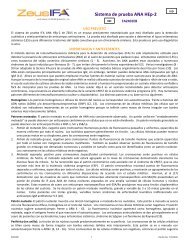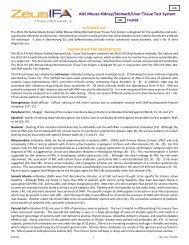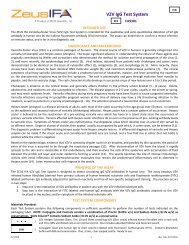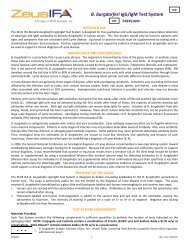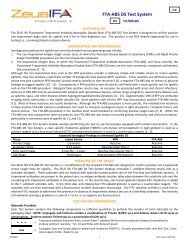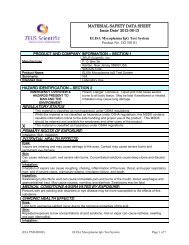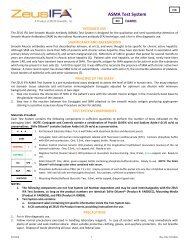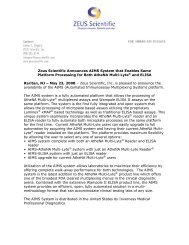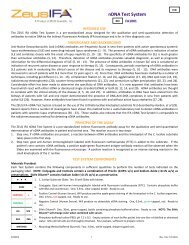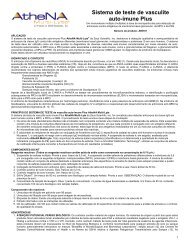English - ZEUS Scientific
English - ZEUS Scientific
English - ZEUS Scientific
Create successful ePaper yourself
Turn your PDF publications into a flip-book with our unique Google optimized e-Paper software.
ecognized to be associated with the CREST syndrome, which is a milder variant of progressive systemic sclerosis<br />
(PSS).<br />
The centromere pattern will demonstrate discrete and uniform points of fluorescent speckles scattered<br />
throughout the nucleus. Mitotic cells will be positive, demonstrating a clustering of the centromeres in the<br />
chromosomes in different arrangements according to the mitotic stage.<br />
Harmon and co-workers (17) demonstrated that serum samples containing highly monospecific anti-SSA/Ro<br />
gave an IF-ANA test pattern of discrete nuclear speckles on a wide variety of human cells and tumor nuclei. Such<br />
serum samples with monospecific anti-SSA/Ro produced very little cytoplasmic staining of substrate cells.<br />
A distinct, large, variable speckled pattern of 3 to 10 large speckles in the nucleus has been described. These<br />
patients with large, variable speckles have undifferentiated rheumatic disease syndromes with IgM antihistone<br />
H-3 antibody (18).<br />
Nucleolar Pattern - The nucleolar pattern demonstrates a homogeneous or speckled staining of the nucleolus. This<br />
pattern is often associated with a dull, homogeneous fluorescence in the rest of the nucleus. The chromosomes in<br />
the mitotic cells will be negative. The nucleolar pattern suggests autoantibodies to 4-6S RNA. The nucleolar<br />
fluorescence will appear as homogeneous, clumped, or speckled, depending on the antigen to which the<br />
autoantibody reacts.<br />
Antinucleolar antibodies occur primarily in the sera of patients with scleroderma, systemic lupus erythematosus,<br />
Sjögren’s syndrome, or Raynaud’s phenomenon (19).<br />
Peripheral (Rim) - The nuclei stain predominantly at their periphery. The chromosomes of the mitotic cells stain as<br />
irregularly shaped masses with more intensely stained outer edges. This pattern is often seen with autoantibodies<br />
to nDNA (3,14-16). If the chromosomes of the mitotic cells are negative, then the pattern would be suggestive of<br />
autoantibodies to the nuclear membrane and not to nDNA, and not reported as a peripheral pattern. (See nuclear<br />
membrane interpretation below).<br />
Additional Patterns<br />
1. Spindle fiber pattern, chromosome-positive:<br />
The spindle fiber pattern is unique to cells undergoing mitosis where only the spindle apparatus fluoresces. This<br />
pattern has a “spider web” appearance extending from the centriole to the centromeres. The pattern is<br />
suggestive of autoantibodies to the microtubules and its significance is unclear; however, an association<br />
between the spindle fiber pattern and carpal tunnel syndrome has been suggested.<br />
2. Midbody pattern:<br />
The midbody pattern is a densely staining region near the cleavage furrow of telophase cells, that is, in the area<br />
where the two daughter cells separate. The clinical significance of the pattern is unknown; however, the pattern<br />
has been recognized in selected patients with systemic sclerosis.<br />
3. Centriole pattern:<br />
The centriole pattern is characterized by two distinct points of fluorescence in the nucleus of the mitotic cells or<br />
one distinct point of fluorescence in the resting cell. The significance of this pattern is not known; however, it<br />
has been observed in PSS.<br />
4. Proliferating cell nuclear antigen (PCNA) pattern:<br />
The proliferating cell nuclear antigen pattern is observed as a fine to course nuclear speckling in 30-60% of the<br />
cells in interphase, and a negative staining of the chromosome region of mitotic cells. The PCNA is very specific<br />
for patients with SLE but not detected in other connective tissue disease disorders. It has been reported that SLE<br />
patients with the PCNA pattern have a higher incidence of diffuse glomerulonephritis.<br />
5. Antinuclear membrane (nuclear laminae):<br />
The antinuclear membrane pattern appears as a rim around the nucleus and resembles a rim pattern; however,<br />
it is distinguished from the rim pattern by the fact that the metaphase chromosome stage is negative. This<br />
autoantibody is important to report because it was recently recognized to be associated with autoimmune liver<br />
disease.<br />
Cytoplasmic Patterns<br />
1. Mitochondrial (AMA) pattern:<br />
The pattern will characteristically have numerous cytoplasmic speckles with the highest concentration in the<br />
peri-nuclear area. The pattern can be observed in interphase and mitotic cells. The clinical significance of AMA is<br />
most frequently an association with primary biliary cirrhosis, especially when the AMA is a high titer.<br />
2



